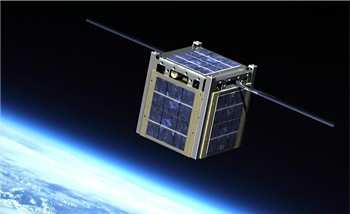Mon, Jul 15, 2013
Three Micro-Thruster Technologies Determined To Have Potential
NASA selected three proposals for the development of lightweight micro-thruster propulsion technologies that are small in size but have big potential. NASA's Space Technology Mission Directorate selected the miniaturized electrospray propulsion technologies to perform stabilization, station keeping and pointing for small spacecraft. NASA hopes these technology demonstrations may lead to similar position control systems for larger spacecraft and satellites as well.

NASA's Game Changing Development Program, managed by the agency's Langley Research Center in Hampton, Va., sponsored this solicitation and will oversee the first phase of this technology development.
The three awards selected for contract negotiations are:
- 'Microfluidic Electrospray Propulsion (MEP)' by NASA's Jet Propulsion Laboratory, Pasadena, CA.
- Miniature ElectroSpray Thrusters Based on Porous Surface Emission' by Busek Company, Inc., Natick, MA.
- 'Scalable ion Electrospray Propulsion System (S-iEPS)' by the Massachusetts Institute of Technology (MIT), Cambridge, MA.
Proposals for this solicitation were received from NASA centers, federally funded research and development centers, universities and industry. At least one electrospray technology will be selected for further development as an in-space flight demonstration through NASA's Small Spacecraft Technology Program during Phase II, which will be made through a separate solicitation.

One of NASA's priorities is to seek and develop new technologies that will radically change the capabilities for small satellites. There currently is a lack of efficient propulsion for a class of low cost, nanosatellite research spacecraft called "Cubesats," which measure about 4 inches on each side and weigh less than 3 pounds. The successful development and demonstration of these miniaturized systems will offer low mass, low-power propulsion for these small spacecraft and potentially revolutionize the future of Cubesats.
Miniaturized electrospray propulsion technologies also signal a revolutionary alternative for position control systems for larger satellites. Several studies have shown that micro-thrusters could replace currently accepted systems on large spacecraft, saving weight and space while significantly increasing mission reliability and lifetimes. This technology also could enable other game changing propulsion capabilities from micro-scale to large, deployable spacecraft structures.
More News
With Testing Soon Complete, Launch Preparations Begin in Earnest Sierra Space's Dream Chaser has been put through the wringer at NASA's Glenn Armstrong Test Facility in Ohio, but w>[...]
Takeoff Roll The process whereby an aircraft is aligned with the runway centerline and the aircraft is moving with the intent to take off. For helicopters, this pertains to the act>[...]
“We’re proud of the hard work that went into receiving this validation, and it will be a welcome relief to our customers in the European Union. We couldn’t be mor>[...]
"Aircraft Spruce is pleased to announce the acquisition of the parts distribution operations of Wag-Aero. Wag-Aero was founded in the 1960’s by Dick and Bobbie Wagner in the >[...]
IDENT Feature The special feature in the Air Traffic Control Radar Beacon System (ATCRBS) equipment. It is used to immediately distinguish one displayed beacon target from other be>[...]
 Sierra Space Repositions Dream Chaser for First Mission
Sierra Space Repositions Dream Chaser for First Mission ANN's Daily Aero-Term (05.10.24): Takeoff Roll
ANN's Daily Aero-Term (05.10.24): Takeoff Roll Aero-News: Quote of the Day (05.10.24)
Aero-News: Quote of the Day (05.10.24) Aero-News: Quote of the Day (05.11.24)
Aero-News: Quote of the Day (05.11.24) ANN's Daily Aero-Term (05.11.24): IDENT Feature
ANN's Daily Aero-Term (05.11.24): IDENT Feature




